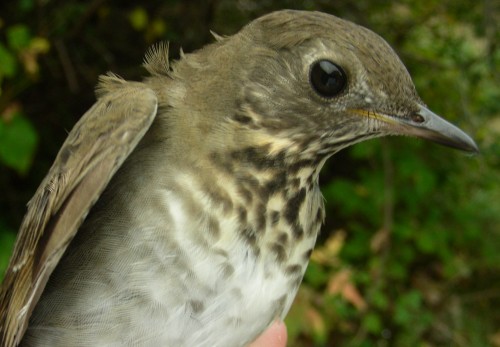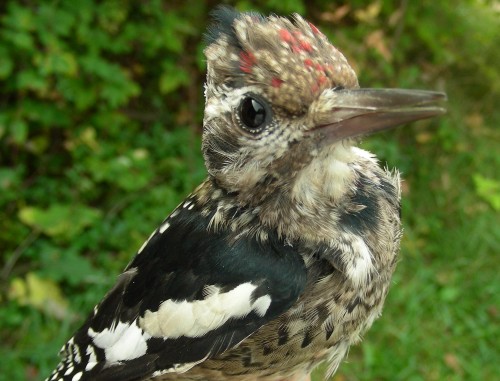|
McGILL BIRD OBSERVATORY |
||||||||||||||||||||||||||||||||||||||||||||||||||||||||||||||||||||
Welcome
to the McGill Bird Observatory weekly report.
Click here for a complete listing of our archives.
Banders-in-charge: Marie-Anne
Hudson, Barbara Frei Notes: This week has shattered our previous ‘big week’ record for 2007 by about 150 birds, and has even surpassed this week’s total for last year (a first for this season). Not only were numbers up, but we also managed to band 13 more species than last year at this time, and 10 more species were observed. As the numbers indicate, we’ve had a pretty big week: our slowest day clocked in at 43 birds banded, and our biggest at 122! Needless to say we’re very thankful for our great volunteers who were fantastic net assistants, scribes and extractors – you made our jobs that much easier. Although the unseasonably warm weather for much of this fall has probably accounted for some of the lower numbers we've seen, at this point in the season it may actually explain the higher diversity in that some of the earlier migrants have lingered a bit later than they usually would. New species observed this week include a special addition to the site list: White-winged Crossbill! We’ve been hoping for this species to make its way from the Arboretum to our site for 3 years, and it finally did. Thanks to Jeff for “gettin’ ‘em!” We're all the more pleasantly surprised as it comes at a time when the White-winged Crossbill populations are peaking in western and eastern Canada, and relatively few appear to be left in Quebec and Ontario. The other new species for the season is the Fox Sparrow, which was also a newly banded species for this season (right on time), along with the Eastern Bluebird – another first for the site! Now that we’ve been in operation for a few years, it’s getting more and more difficult to get new species for the banded list, so we’re especially excited for the addition of the bluebird, which brings the count to 103. As was suggested in last week’s report, Ruby-crowned Kinglets tend to peak around Thanksgiving, and sure enough, this week has been full of kinglets, with an almost 2:1 ratio of them compared to White-throated Sparrows. They vaulted to the top of the list this week, followed by the ever-increasing American Robin, already tied with the White-throated Sparrow. Also on the increase was the number of Black-capped Chickadees. This week has very much confirmed that we’re being invaded by northern chickadees that tend to be larger and stocked with fat reserves. The number of Yellow-rumped Warblers is up from last week, but still nowhere near last year’s numbers. Slipping a little from last week in the standings but still holding their own: White-crowned Sparrows, which really love the J-trap even when it’s not set, Song Sparrows, American Goldfinch and Swamp Sparrow round out the top ten.
The top 10 observed list is fairly similar to last week’s, with the Canada Geese filling the sky, and more than twice as numerous as they were at this point last year. American Robin numbers are steadily increasing, and also slightly ahead of their 2006 numbers. They’re most vocal first thing in the morning, making the poplars over the B/N nets positively deafening. The juncos have finally made their appearance on the top 10 list after being on site for a few weeks now. The major influx came a few days ago, and they’ve been on the increase ever since. Owling has been fairly successful thus far, with 5 owls banded over 3 nights total. We’re hoping for lots more over the next few nights, as steady northeast winds have been forecast. The biggest news so far is that the owling program also generated a new addition to the all-time checklist this week, in the form of a Barred Owl perched on the reliable old dead tree at the north end of Stoneycroft Pond. It became species #191 on the list, our eleventh addition this year (the others in chronological order being Ring-necked Duck, Vesper Sparrow, Sandhill Crane, Eastern Meadowlark, Eastern Towhee, and Greater Scaup in spring, followed by some new sightings this fall - Least Sandpiper, Common Moorhen, Clay-colored Sparrow, and this week's White-winged Crossbill).
|



